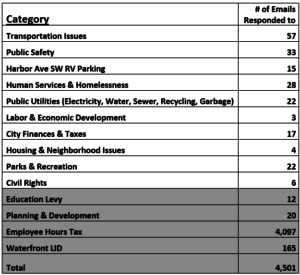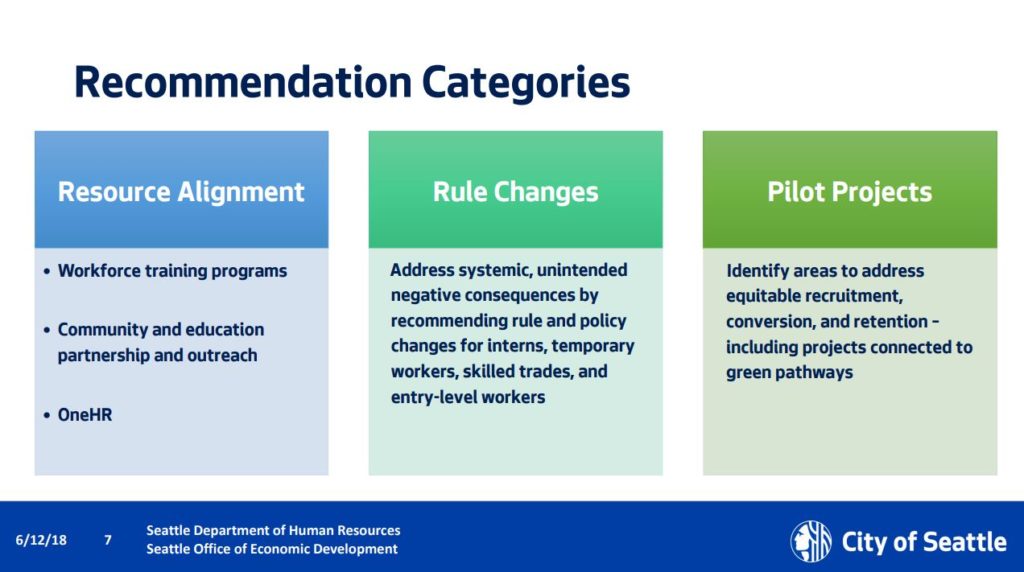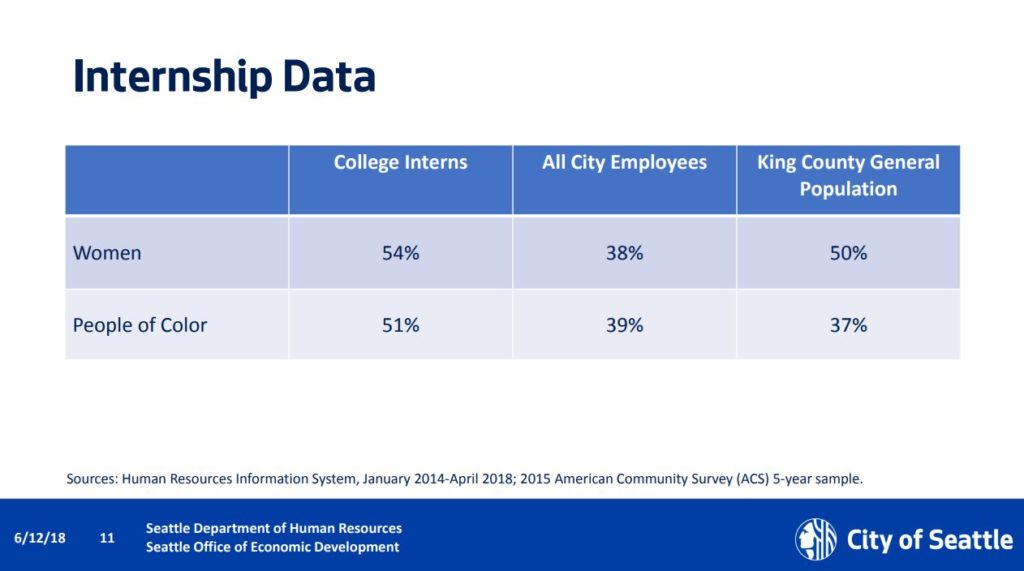Community Resident Preference Policies; Avalon/35th update and online project survey; Capital Projects Transparency and Accountability Update; Green Pathways Update; May Constituent Email Report
Community Resident Preference Policies
During passage of the Mandatory Housing Affordability program for Chinatown/International District (C/ID) last year the Council passed a companion resolution in order to try to address the concerns that the community had about the impact of the zoning changes, in particular impacts that would accelerate displacement of longtime C/ID residents. One of the issues in the resolution related to the need for Seattle to develop community resident preference policies.
This week in my Civil Rights, Utilities, Economic Development, and Arts committee the Office of Civil Rights and Office of Housing gave a presentation about how Seattle could develop and utilize community resident preference polices to fight displacement.
Community preference polices are a different type of tool to fight displacement. The common approaches to implement community resident preferences include:
- A portion of rental or ownership units in affordable development are set-aside
- Preferred applicants may be local residents, workers, former residents, people who have been displaced
- Lottery used to select affordable housing residents/buyers
- Policy must affirmatively further fair housing- explicit analysis of racial impact.
Community resident preferences could address historic and current displacement by providing preference for community residents. If done correctly, these policies could provide affordable housing opportunities, support at-risk communities, and stop segregation. When written poorly on the other hand, community resident preferences can perpetuate segregation. Examples of how community resident preferences affect the housing market in high-cost cities can be found in New York City, San Francisco, and Portland.
There has been a direct community preference policy in New York City since the 1980s. It applies to all city funded projects. 50% of units have a mandated neighborhood resident preference at lease-up. Although the policy was originally intended to prevent displacement, in recent years it has maintained gentrification of the City. In Janell Winfield, et al. v. City of New York, Index No. 15-cv-05236, Dkt. No. 16 (S.D.N.Y. Sept. 8, 2015), Winfield is challenging New York City’s policy regarding the allocation of affordable housing units in new housing developments located in relatively safe, affluent neighborhoods. They allege that the policy improperly favors individuals who already reside in these neighborhoods. Winfield is arguing that due to the fact the current make-up of the neighborhood is traced in historical restrictions and intentional discrimination, the policy has a disproportionate effect on people of color.
In San Francisco, a neighborhood preference policy has been in place since 2016. The preference is given to people who either live in the district or live within a half mile of the district. 40% of units are subject to this neighborhood preference policy. All HUD- funded projects are exempt, but a compromise has been made between San Francisco and HUD in support of a separate preference policy to be used for projects funded by HUD. If a project is funded by HUD, preference must be given for any resident of six high displacement neighborhoods.
In 2016 Portland created their community preference policy, which only applies to Northeast Portland, which is historically an African American neighborhood. Northeast Portland’s African American population has shrunk from 80% to 15% over time due to urban renewal, construction, and other displacement tactics. Portland’s policy takes generational displacement into consideration by applying the preference to prior residents, in addition to current residents. To increase the amount of affordable housing available in Northeast Portland, the City has also pledged $20 million in funding to go towards new housing projects, in which the community preference policy will utilized to pick the inhabitants. The preference policy also has a point system (0-6), the highest points are given to someone whose property was taken by eminent domain.
In looking towards the future, I believe we can use affirmative market and community preference policies to help communities in Seattle that have a high rate of displacement. However, the policies and marketing tools implemented in the City must be written carefuly to take into consideration Seattle’s history of racial covenants and redlining.
Avalon/35th Update and Online Project Survey
The SW Avalon Way & 35th Avenue SW project has reached 30% design.
The project, scheduled to begin in 2019, includes repaving Avalon, between SW Spokane Street at the bridge and 36th Avenue SW. It also includes paving 35th Avenue SW from SW Avalon to SW Alaska Street, and SW Alaska between 35th Avenue SW and 36th Avenue SW.
Better bus access to the West Seattle Bridge is included, with parking restrictions proposed from 6-10 a.m. Monday through Friday leading up to the bridge to allow for a transit-only access. This is for 23 spaces; they were formerly proposed for elimination. Avalon is a key bus corridor for exiting and accessing the peninsula. Some parking removal is proposed for the east side of the street near the bridge.
A protected bike lane is also included, as noted in the Bicycle Master Plan, and listed for 2019 implementation in the 2017-2021 Implementation Plan. The bike lane implementation is included with the paving project to minimize costs.
SDOT has a public survey available through June 17 about this project.
SDOT’s paving projects website notes that they “prioritize paving based on street pavement condition, traffic volume, geographic equity, cost, and opportunities for grants or coordination with other projects in the area.” Background on pavement management policies is here.
The next step for the project is to consider public feedback, and complete 60% design, then hold a public forum and consider additional constituent comments.
Maps for 30% design, including cross sections of what the street would look like, are available at the project website. You can sign up for e-mail updates here.
Capital Projects Transparency and Accountability Update
The Council has received a report on Capital Improvement Project Transparency from SDOT which it required through the budget process.
It represents a good step forward from a month ago, when the Council received an Update on Capital Project Oversight at a Council Briefings meeting. That briefing described a new enhanced monitoring risk-analysis oversight process for individual major capital projects that will allow elected officials and the City Budget Office to identify projects that are over (or under) budget on a quarterly basis, and take necessary action.
At the May 7th briefing I noted my concern that though this was progress for individual project monitoring, the City’s Capital Budget also includes some programmatic areas of spending which include numerous individual projects, such as street paving and bike lanes. Consequently, the quarterly reports for individual projects would miss important details—such as the 1/3 mile bike lane that cost $3.8 million, or $12 million per mile. I noted I want this quarterly monitoring to include programmatic areas as well.
SDOT’s report Capital Improvement Project Transparency notes that in the future quarterly oversight reports would include quarterly reports status updates on the ongoing programs included in department capital improvement program accomplishment rate. While details are still being worked out with the City Budget Office about how to incorporate this into reports, it’s a positive step forward for transparency and accountability.
In October 2016 the Council passed the Green Pathways Resolution. I wrote about it at the time, but here’s a quick refresher about it. It asked for 1. a green job definition that is consistent with community principles, 2) that the Interdepartmental Team (IDT) on employment pathways create an inventory of internships, apprenticeships, and entry-level jobs at the City of Seattle that meets the green jobs definition, 3) that an outreach and engagement strategy identify barriers to success for people of color, and 4) that the IDT identify ways to encourage employers in the private sector to advance in-demand careers, including green jobs for people of color and other underrepresented groups. Additionally, in the 2016 budget the Council allocated funds to support this work through a full-time position within Human Resources (HR).
On Tuesday we heard an update from the IDT as well as young leaders from Got Green. HR provided some high-level recommendations:
HR also provided some useful data comparing entry-level position/green positions/internships and others to that of all City employees and also to the general population of King County so that the Council could get an understanding of how the City is preforming in terms of diversity. One of the areas in which the City needs significant improvement is college intern conversion rate to permanent City jobs, which is only at 16%, while the national rate for college intern conversion is 38%. The City excels with internship demographics as shown in this slide:
Therefore, and especially because the City is making investments with interns, we must strive for a significantly better conversion rate of interns to full and part time employees.
However, it became clear at the committee meeting that community recommendations from Got Green had not yet been considered by the IDT for this report. I asked the Young Leaders of Got Green to also send those recommendations to Council so that we could be better informed and advocates on their behalf with the IDT to ensure that their concerns and recommendations were being addressed.
In moving forward, the IDT will continue to analyze the data and identify barriers to success for people of color and other underrepresented groups to set a baseline and make final recommendations to the Council by the end of this year.
Constituent correspondence is a very important task in my office. My staff and I spend time every day helping you improve our community, whether that’s through getting you help from a city department with our constituent case management services or giving you information about legislation that the Council is considering. The unshaded categories and numbers are problem-solving emails answered in May, what I refer to above as “case management services.” The shaded categories and numbers are emails answered in May related to policy or legislation the Council is considering.

Posted: June 15th, 2018 under Councilmember Herbold, Libraries, Office of Police Accountability, Transportation
Tags: bike lane, bus access, Capital Improvement Project Transparency, Chinatown/International District, constituent e-mails, Green Pathways, housing development, Mandatory Housing Affordability, SDOT, SW Avalon Way & 35th Avenue SW project



